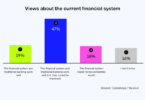Today the Basel Committee on Banking Supervision launched a consultation on disclosures relating to crypto-assets. Late last year, it published the final crypto-asset rules, including general disclosure requirements. Now the Basel Committee has provided detailed spreadsheet templates for the disclosures. To avoid window dressing, it requires average daily amounts as well as the period end figures.
The consultation runs to January 31 and the templates will come into force at the same time as the crypto-asset rules, January 1, 2025.
Crypto-assets include tokenized traditional securities and commodities, stablecoins and cryptocurrencies.
Apart from twice yearly figures, the templates include qualitative details requiring annual reporting. This helps regulators to gain clarity about how a bank is engaging in the crypto-asset sector. For example, whether it’s holding crypto directly, trading on behalf of clients, or investing in exchanges or fund managers.
Indicator of stablecoin concerns?
One point stands out in the consultation because it seems more specific, highlighting a potential area of concern. There’s an explicit requirement for banks to state whether they provide redemption services for stablecoins. “In such cases, banks must describe their role and the extent of any commitments to redeem or purchase back cryptoassets that may result from those activities.”
Reading between the lines, there’s a concern that a run on a stablecoin could translate into a run on a bank.
The Basel rules divide crypto-assets into two risk categories – lower and higher risk. Category 1 (low risk) includes tokenized traditional assets and stablecoins. However, there are four sets of requirements to qualify. And if a token or stablecoin doesn’t meet the criteria, they are treated the same as the high risk Group 2, which mainly includes cryptocurrencies. Group 2 assets have a 1250% risk weighting – the highest possible. That means banks have to hold a dollar in capital for every dollar in crypto.
A key part of the qualitative assessment is clarifying how the bank has decided the Group 1 assets meet the conditions. It requires a considerable amount of work and disclosures for stablecoins. For example, this includes legal enforceability in all jurisdictions. The DLT or blockchain needs to be designed to mitigate risks. And entities with key roles must be regulated and have appropriate governance. The roles include redemptions, transfers, storage, settlement or managing stablecoin reserves.
Revisiting permissionless blockchains, stablecoins
The Basel Committee previously stated it was revisiting the conditions for permissionless blockchains and stablecoin requirements. The permissionless blockchain aspect could have an impact on tokenized securities. For stablecoins, the focus areas are statistical stability tests (temporarily dropped from the final crypto-asset requirements), the composition of reserve assets and redemption tests.
Meanwhile, the Basel figures for the end of 2022 indicate banks have very little crypto exposure, particularly in the United States.






